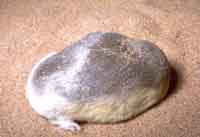Afrosoricida
Order of mammals From Wikipedia, the free encyclopedia
The clade Afrosoricida (a Latin-Greek compound name which means "looking like African shrews") contains the golden moles of Southern Africa, the otter shrews of equatorial Africa and the tenrecs of Madagascar. These three groups of small mammals were for most of the 19th and 20th centuries regarded as a part of the Insectivora or Lipotyphla, but both of those groups, as traditionally used, are polyphyletic.
| Afrosoricida Temporal range: | |
|---|---|
 | |
| Lesser hedgehog tenrec (Echinops telfairi) | |
 | |
| Grant's golden mole (Eremitalpa granti) | |
| Scientific classification | |
| Domain: | Eukaryota |
| Kingdom: | Animalia |
| Phylum: | Chordata |
| Class: | Mammalia |
| Mirorder: | Afroinsectivora |
| Order: | Afrosoricida Stanhope MJ, Waddell VG, Madsen O, de Jong W, Hedges SB, Cleven G, Kao D, Springer MS, 1998 |
| Subclades | |
|
†Afrodon | |
 | |
Naming
Summarize
Perspective
Some biologists use Tenrecoidea or Tenrecomorpha as the name for the tenrec-golden mole clade and regard Afrosoricida as a junior synonym (even though the rules of the ICZN do not apply above the Linnean rank of family). This is based on the principles of Simpson,[1] summarized by Asher & Helgen[2] to mean that "priority and stability should comprise the overriding principles by which new, high-level taxa are named. Established names for any given clade should not be altered unless the name with precedent unambiguously threatens stability." When "Afrosoricida" was first named in 1998, Afrosorex was a subgenus of Crocidura and McDowell[3] had used the name Tenrecoidea for the same clade of golden moles and tenrecs. Gary Bronner and Paula Jenkins referred to "Afrosoricida" in their chapter in Wilson & Reeder[4] as "... inappropriate since this clade does not include soricids, and could lead to confusion with the soricid subgenus Afrosorex" but still kept it due to their perception that the name was "entrenched in the recent literature" and because of the admittedly confusing history of terms like Tenrecoidea and Tenrecomorpha.[5] Asher & Helgen[2] presented their views on the appropriateness of these and other high-level taxa, including a response[6] to Hedges,[7] who supported keeping "Afrosoricida".
Biology
As a rule, tenrecs and otter shrews tend to be small animals varying from 4 cm to 39 cm in length. There is no pronounced body type since they have evolved to occupy a number of small-bodied, faunivorous niches in Madagascar (tenrecines) and mainland Africa (potamogalines). However, certain species bear some ecological similarity to hedgehogs, soricid shrews, or miniature otters. Their coat can vary from smooth to spiny and the coloration of the fur can also vary from brown, gray, to other hues (see for example photos on the ASM library[8]). Most species are also nocturnal and have poor eyesight. Their whiskers are rather sensitive and they can detect very minute vibrations in the ground to locate their prey.
Unusual among placentals, afrosoricids have a cloaca, which is the rear orifice that functions as the opening for the urinary, digestive, and reproductive tracts.[9]
Phylogeny
Summarize
Perspective
Traditionally, these two families were grouped with the hedgehogs, shrews and moles in the Lipotyphla. However, there have always been minority opinions suggesting that Tenrecoidea, or at least the golden moles, are not true lipotyphlans. For example, Robert Broom wrote in 1916[10] that "examination of the skull confirms ... that Chrysochloris is not a near ally of Centetes" (i.e., Tenrec ecaudatus) "and that it is not an Insectivore". These opinions are now supported by many genetic studies indicating an association between tenrecoids and various other African mammals in the Afrotheria.[11][12][13][14] Tenrecs and golden moles are sometimes considered part of the Afroinsectiphilia, a clade within Afrotheria.
Cladogram of living Afrosoricida
The generally accepted cladogram of living Afrosoricida is:[13][14]
| Afrosoricida |
| ||||||
Species
- Infraclass Eutheria: placental mammals
- Superorder Afrotheria
- Clade Afroinsectiphilia
- Clade Afroinsectivora
- Order Afrosoricida
- Suborder Tenrecomorpha (otter shrews and tenrecs)
- Family Potamogalidae (otter shrews)
- Family Plesiorycteropodidae
- Genus †Plesiorycteropus
- †Plesiorycteropus madagascariensis
- †Plesiorycteropus germainepetterae
- Genus †Plesiorycteropus
- Family Tenrecidae (tenrecs)
- Subfamily Geogalinae (1 species)
- Genus Geogale
- Subfamily Oryzorictinae (24 species)
- Genus Microgale
- Short-tailed shrew tenrec (Microgale brevicaudata)
- Cowan's shrew tenrec (Microgale cowani)
- Drouhard's shrew tenrec (Microgale drouhardi)
- Dryad shrew tenrec (Microgale dryas)
- Pale shrew tenrec (Microgale fotsifotsy)
- Gracile shrew tenrec (Microgale gracilis)
- Naked-nosed shrew tenrec (Microgale gymnorhyncha)
- Jenkins's shrew tenrec (Microgale jenkinsae)
- Northern shrew tenrec (Microgale jobihely)
- Lesser long-tailed shrew tenrec (Microgale longicaudata)
- Major's long-tailed tenrec (Microgale majori)
- Web-footed tenrec (Microgale mergulus)
- Montane shrew tenrec (Microgale monticola)
- Nasolo's shrew tenrec (Microgale nasoloi)
- Pygmy shrew tenrec (Microgale parvula)
- Greater long-tailed shrew tenrec (Microgale principula)
- Least shrew tenrec (Microgale pusilla)
- Shrew-toothed shrew tenrec (Microgale soricoides)
- Taiva shrew tenrec (Microgale taiva)
- Thomas's shrew tenrec (Microgale thomasi)
- Subgenus Nesogale
- Genus Oryzorictes
- Genus Microgale
- Subfamily Tenrecinae (5 species)
- Tribe Setiferini
- Tribe Tenrecini
- Subfamily Geogalinae (1 species)
- Suborder Chrysochloridea (golden moles)
- Family Chrysochloridae (golden moles)
- Subfamily Chrysochlorinae (11 species)
- Genus Carpitalpa
- Genus Chlorotalpa
- Genus Chrysochloris
- Subgenus Chrysochloris
- Subgenus Kilimatalpa
- Genus Chrysospalax
- Genus Cryptochloris
- Genus Eremitalpa
- Subfamily Amblysominae (10 species)
- Genus Amblysomus
- Genus Calcochloris
- Subgenus Huetia
- Subgenus Calcochloris
- Subgenus incertae sedis
- Genus Neamblysomus
- Subfamily Chrysochlorinae (11 species)
- Family Chrysochloridae (golden moles)
- Suborder Tenrecomorpha (otter shrews and tenrecs)
- Order Afrosoricida
- Clade Afroinsectivora
- Clade Afroinsectiphilia
- Superorder Afrotheria
See also
References
Wikiwand - on
Seamless Wikipedia browsing. On steroids.
